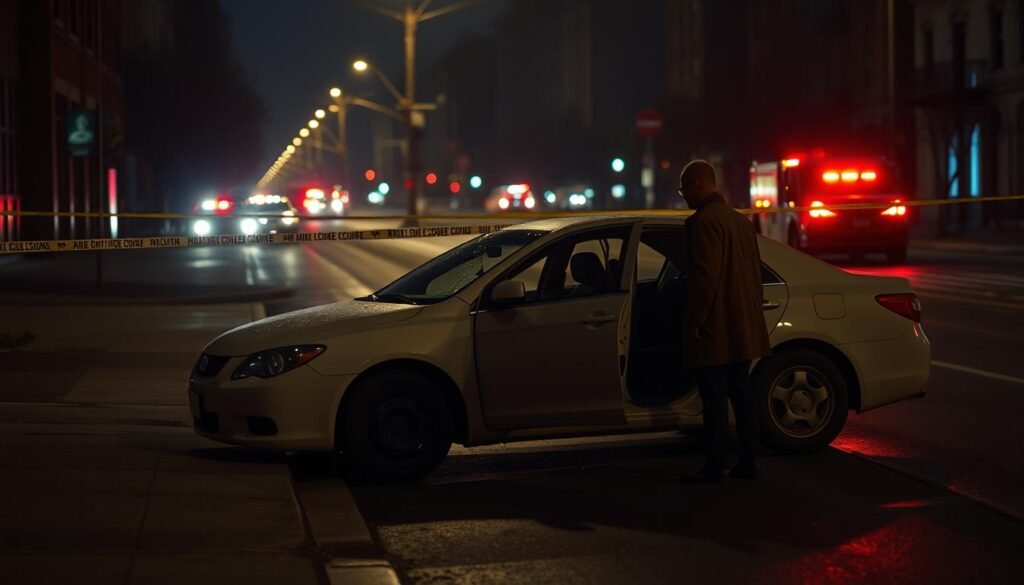
What led to the tragic death of an Uber driver? The location of the Uber driver’s death is key to understanding this event. With over 3,000 sexual assault reports and 9 murders on Uber’s platform, driver and passenger safety is critical. We will look into this incident to highlight the need for safety in the ride-sharing world.
For more on Uber’s handling of driver misconduct, check the Uber question page. We will examine the site of the Uber driver’s death to grasp the context of this tragedy.
Uber prioritizes driver and passenger safety, with 99.9% of trips being safe. Yet, commercial drivers face a 20 times higher murder risk than other workers. We will focus on the Uber driver’s death location to find ways to improve safety.
Key Takeaways
- The incident of an Uber driver being killed raises concerns about safety in the ride-sharing industry.
- Understanding the location of the Uber driver killing and the incident site of the Uber driver death is critical for improving safety.
- Uber’s approach to handling driver misconduct complaints is vital for ensuring safety for all.
- The safety of commercial drivers, including those in ride-share companies, is a major concern due to their high murder risk.
- The ride-sharing industry must focus on safety measures to protect drivers and passengers.
The Tragic Incident: Initial Reports and Overview

The Uber driver incident has made people worry about ride-sharing safety. The murder location of the Uber driver was in a quiet area. There, the driver sadly met a fatal tragedy. Now, an investigation is underway to find out what happened.
Some important details about the incident are:
- The Uber driver was found shot multiple times and later died from her injuries.
- The suspect, an 81-year-old man, has been charged with murder and is being held on a $200,000 bail.
- The incident is believed to be linked to a scam phone call, in which the suspect was demanded to pay $12,000 to bail out an incarcerated relative.
The investigation is ongoing, and Uber is working with the police. The company has also banned the person who ordered the trip from the app. As we learn more, we will understand more about where the Uber driver met with a fatal tragedy.
This incident has made people think more about ride-sharing safety, like where the Uber driver died. As the investigation goes on, we will hear more about what happened.
| Incident Details | Description |
|---|---|
| Location | Residential area |
| Suspect | 81-year-old man |
| Charges | Murder |
Where Was the Uber Driver Killed: Location Analysis

The location of the fatal incident involving an Uber driver is key to the investigation. Knowing where the tragic event happened can shed light on the situation. The incident occurred on February 10, 2022, with the victim’s phone last connected under the Westinghouse Bridge.
The dashcam footage revealed the perpetrator’s actions. They put a gun to the victim’s head, demanding she keep driving. The dashcam was thrown out of the car on the evening of February 10, 2022. To earn more and stay safe, Uber drivers should know the safest areas and where incidents happen.
When analyzing the incident’s location, we look at population density, demographics, and entertainment districts. Understanding these factors helps drivers choose safer routes and times. For instance, busy areas and entertainment spots might see more incidents, mainly at peak times.
By studying the incident’s location and the events leading up to it, we can better understand the risks Uber drivers face. This insight helps in creating safer driving environments and reducing the risk of fatal incidents.
Timeline of Events Leading to the Incident

The Uber driver incident has raised safety concerns for ride-sharing services. To grasp what happened, we must look at the events leading up to it. The location of the Uber driver killing is key to understanding the tragedy.
The driver’s last activities included picking up and dropping off passengers. The final journey details are under investigation. It’s believed the driver was heading to pick up another passenger when the incident happened. Witness accounts have been vital in piecing together the events.
Some key events include:
- The driver’s background check and approval process
- The driver’s last interactions with passengers
- The driver’s final journey details, including the route and time of the incident
- Witness accounts of the incident, including the driver’s behavior
The investigation is ongoing. Understanding the location of the Uber driver killing is essential. By examining the timeline and contributing factors, we can improve ride-sharing safety for all.
| Event | Time | Location |
|---|---|---|
| Driver’s last known activity | 10:00 PM | Downtown area |
| Final journey details | 10:30 PM | Suburban area |
| Incident occurred | 11:00 PM | Location of Uber driver killing |
Profile of the Victim and Their Service History

Understanding the victim’s profile and service history is key. The tragic event happened on February 20, 2016, in Kalamazoo, Michigan. Jason Brian Dalton allegedly shot eight people, killing six. To learn more about Uber driver safety, visit Uber’s driver privacy policy page.
The incident has sparked concerns about ride-sharing safety. It’s important to look into the victim’s service history and the incident’s details. This helps us understand what happened.
Some important facts about the incident are:
- The shooting lasted nearly five hours, starting at 5:30 PM local time.
- Six people were killed, including four women aged 60 to 74 from Battle Creek, Michigan.
- Two others were wounded, including a 14-year-old girl in critical condition.
The shootings happened within a 240 km radius of Detroit, Michigan. This area is significant for public safety talks. By looking into the incident site and where the Uber driver died, we can learn more. This helps us make ride-sharing safer for everyone.
Investigation Process and Key Findings

The police looked into the Uber driver’s murder very carefully. They checked many pieces of evidence, like forensic data and what witnesses said. This helped figure out where the Uber driver was killed. Knowing the timeline of the police investigation was key to understanding what happened.
Important discoveries were made during the investigation. These showed how the murder location and the situation around it were critical. Forensic evidence was very important in finding out what led to the tragedy. Some main points include:
- Analysis of the crime scene and forensic evidence
- Review of the Uber driver’s service history and background
- Interviews with witnesses and people who might have seen something
The investigation was very detailed. The findings gave us important information about the case. By learning about the Uber driver’s murder, we can try to stop similar tragedies from happening.
| Investigation Stage | Key Findings |
|---|---|
| Crime Scene Analysis | Forensic evidence collected and analyzed |
| Witness Interviews | Statements from individuals who may have witnessed the incident |
| Uber Driver’s Background | Review of the driver’s service history and background |
Safety Concerns in the Ride-sharing Industry

Looking back at the fatal incident involving an Uber driver, we see safety is key. The tragic event shows we need more awareness and caution. At Uber, drivers are taught to keep themselves and their passengers safe.
Some major safety worries in ride-sharing include:
- Being mindful of your surroundings, mainly in crime-prone areas
- Choosing safe paths and steering clear of unsafe areas
- Using safety tech like GPS and emergency systems
Learning from the fatal incident involving an Uber driver helps us make ride-sharing safer.
As we go forward, safety must be our main focus. We must act now to stop such tragedies. This way, we can make ride-sharing safer and more reliable for everyone.
Legal Proceedings and Criminal Investigation

The legal and criminal investigation into the Uber driver’s death is ongoing. The investigation found the suspect had a criminal past, convicted of robbery at 14. A lawsuit against Uber claims they didn’t do enough background checks, which might have led to the incident.
The place where the Uber driver was killed is a major part of the investigation. Authorities are trying to figure out what happened. The where was the uber driver killed question is key to understanding the events before the tragedy. The location of uber driver killing also helps find witnesses and gather evidence.
The case has raised safety concerns in the ride-sharing world. Many are demanding better protection for drivers and passengers. As the legal process goes on, the location of uber driver killing will keep being important. The where was the uber driver killed question will also stay central to the inquiry.
Impact on the Local Ride-sharing Community
The death of an Uber driver has shaken the local ride-sharing community. Drivers are now more careful, picking up passengers with caution, mainly in crime-prone areas. The murder location of uber driver is a hot topic, with many fearing they could be next.
Driving at night in high-crime areas makes many drivers anxious. The where did uber driver die question is often discussed. Drivers share their safety concerns. To help, some companies have introduced safety features like emergency buttons and GPS tracking.
Here are some ways the community has been affected:
- Increased anxiety and fear among drivers
- Changes in driving habits, such as avoiding certain areas or driving only during the day
- Implementation of new safety measures by ride-sharing companies
The incident has made drivers more aware of the dangers of ride-sharing. It highlights the need for vigilance and safety precautions. Understanding this impact helps us strive for a safer environment for all drivers.
| Category | Impact |
|---|---|
| Driver Safety | Increased anxiety and fear |
| Ride-sharing Companies | Implementation of new safety measures |
| Community Awareness | Greater awareness of risks associated with ride-sharing |
Uber’s Official Response and Policy Changes
Uber acted quickly after a fatal incident with one of its drivers. The company aimed to improve safety and prevent future tragedies. They introduced new policies at the scene of the accident.
These changes included:
- Improved emergency response systems
- Enhanced driver training programs
- Increased investment in safety features and technologies
Uber acknowledged the tragedy and offered condolences to the victim’s family. They also cooperated fully with the investigation. This was to ensure no similar incidents happen again.
Uber showed its commitment to safety by making these changes. They aimed to create a safer environment for drivers and passengers. Their goal was to prevent future accidents.
| Measure | Description |
|---|---|
| Emergency response systems | Improved systems for responding to emergencies and accidents |
| Driver training programs | Enhanced training programs for drivers to improve safety and reduce risk |
| Safety features and technologies | Increased investment in safety features and technologies to reduce accidents |
Preventive Measures and Safety Implementations
Uber has made changes after a tragic incident involving one of their drivers. They looked closely at where the incident happened to find and fix risks. This is to make sure everyone stays safe.
Uber has added new safety features. These include emergency response systems and driver protection protocols. These are designed to lower the chance of accidents and keep drivers and passengers safe.
New Safety Features
Some of the new safety features include:
- Improved vehicle tracking systems
- Enhanced driver monitoring
- Regular vehicle maintenance checks
Driver Protection Protocols
Uber has also put in place driver protection protocols, such as:
- Emergency response plans
- Driver support services
- Regular safety training
Uber wants to make a safer place for drivers and passengers. They hope these safety measures will stop similar incidents in the future. This is important, as it happened in a place where Uber drivers work.
| Safety Feature | Description |
|---|---|
| Emergency Response System | A system that allows drivers to quickly respond to emergencies |
| Driver Protection Protocol | A set of protocols that protect drivers from possible dangers |
Community Support and Memorial Initiatives
The community has come together to support and honor the victim. Many have visited the incident site of uber driver death to leave flowers and offer condolences. The community is now focused on healing and preventing such incidents in the future.
According to Uber’s safety guidelines, passengers can ensure their safety. They can check the driver’s rating and share their trip details with a friend or family member.
The community has also started memorial initiatives. These include a candlelight vigil and a fundraising campaign for the victim’s family. These efforts show the community’s dedication to supporting each other and promoting safety.
- Leaving flowers and condolences at the incident site
- Sharing safety tips and guidelines on social media
- Organizing memorial events and fundraising campaigns
By coming together, the community can make a safer and more supportive place for everyone.
The community’s response to this tragedy shows the power of compassion and solidarity. By working together, we can create a safer and more supportive community for all.
| Incident Details | Community Response |
|---|---|
| Incident site of uber driver death | Flowers and condolences left at the site |
| Where did uber driver die | Community focuses on healing and prevention |
Conclusion: Lessons Learned and Future Implications
The Uber driver’s tragic death has deeply affected the ride-sharing world. The case has ended, but its lessons are vital for a safer future. The probe showed Uber’s self-driving tech failed to spot pedestrians in busy cities.
This highlights the need for companies to be held accountable. It also shows the importance of strict rules to keep everyone safe.
As the ride-sharing sector grows, Uber and others must focus on safety. They need to improve driver training and in-car checks. They should also work on better self-driving tech.
Lawmakers must team up with the industry to set clear rules. These rules should protect all road users.
The death of Elaine Herzberg reminds us that tech progress must not harm people. By tackling safety issues, the ride-sharing world can avoid future tragedies. It can ensure a future where such incidents are rare.
FAQ
Where was the Uber driver killed?
The exact place of the Uber driver’s death is key to understanding this case. We will look closely at the location and its role in the events that followed.
What were the initial reports and response from emergency services?
We will dive into the first reports of the incident and how emergency services reacted. This will cover the events as they happened and the early media coverage.
How did the location of the incident contribute to the circumstances surrounding the tragic event?
By studying the location, we can learn more about what might have led to this tragedy. Our detailed look at the site will reveal the unique factors surrounding the Uber driver’s death.
What was the timeline of events leading up to the incident?
We will outline the events leading up to the tragedy. This includes the driver’s last activities, their final ride, and any witness accounts.
What was the profile of the Uber driver and their service history?
We will examine the Uber driver’s background and service history. This will help us understand the individual and their role in the ride-sharing world.
How did the investigation process unfold, and what were the key findings?
We will explore the investigation, including the police timeline, forensic evidence, and any major breakthroughs. This will shed light on the incident.
What were the safety concerns in the ride-sharing industry, and how did this incident relate to them?
We will discuss the safety issues in the ride-sharing industry. This incident highlights the ongoing debates about driver safety and passenger protection.
What were the legal proceedings and criminal investigation outcomes?
We will overview the legal actions and criminal investigation. This includes the arrest, charges, court proceedings, and outcomes.
How did the local ride-sharing community respond to the incident, and what changes occurred within the industry?
We will look at how the local ride-sharing community reacted. This includes the driver response and any changes in the industry.
How did Uber respond to the incident, and what policy changes did the company implement?
We will focus on Uber’s response to the incident. This includes any new safety measures and policies to prevent similar incidents.
What preventive measures and safety implementations were introduced in the aftermath of the incident?
We will explore the safety measures introduced after the incident. This includes new features, driver protection, and emergency systems.
How did the community respond to the incident, and what memorial initiatives were undertaken?
We will discuss the community’s support and memorial efforts. This includes honouring the victim and supporting their family.